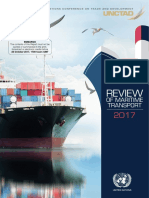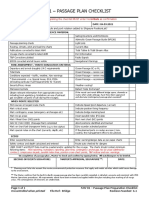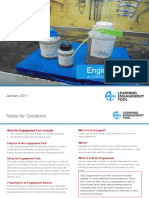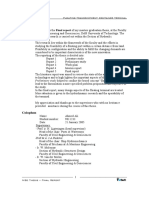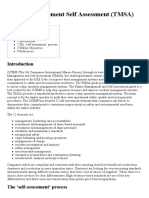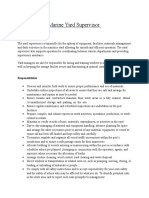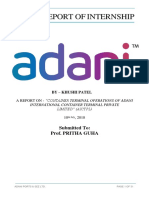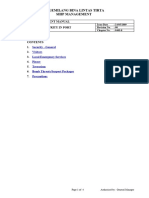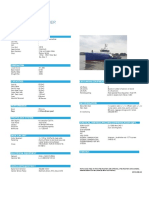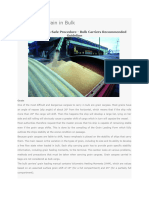0405-5 Preparation For Arrival at Port
0405-5 Preparation For Arrival at Port
Uploaded by
Wisnu WicaksonoCopyright:
Available Formats
0405-5 Preparation For Arrival at Port
0405-5 Preparation For Arrival at Port
Uploaded by
Wisnu WicaksonoOriginal Title
Copyright
Available Formats
Share this document
Did you find this document useful?
Is this content inappropriate?
Copyright:
Available Formats
0405-5 Preparation For Arrival at Port
0405-5 Preparation For Arrival at Port
Uploaded by
Wisnu WicaksonoCopyright:
Available Formats
PT GEMILANG BINA LINTAS TIRTA
SHIP MANAGEMENT
SAFETY MANAGEMENT MANUAL
Issue Date : 14/05/2009
PREPARATION FOR ARRIVAL AT PORT Revision No. : 00
Chapter No. : 0405-5
CONTENTS
1. Preamble
2. General
3. Times of Arrival
4. Charts/Tides/Hydrographic Information/Drafts
5. Navigational Equipment and Stabilisers
6. Cargo Handling Equipment
7. Mooring Machinery and Ropes
8. Bond and Other Stores and Documentation
9. Data Loggers and Clock Synchronisation
10. Sea Water Intakes/Standby Generator
11. Testing of Engines Ahead and Astern
12. Steering Gear
13. Notice to Engine Room
14. Fuel Change Over
15. Evaporators
16. Personnel Required in Engine Room
17. Main engine Manoeuvring Speeds
18. Correct Rigging
19. Berthing Policy Agreed Master/Pilot
20. VHF Channels and Hand Held Radios
21. Berthing Instructions Passed to Crew
22. Preparation for Arrival - Points to Consider
Page 1 of 7 Authorised by : General Manager
PT GEMILANG BINA LINTAS TIRTA
SHIP MANAGEMENT
SAFETY MANAGEMENT MANUAL
Issue Date : 14/05/2009
PREPARATION FOR ARRIVAL AT PORT Revision No. : 00
Chapter No. : 0405-5
1. PREAMBLE
The following procedure is to be carried out in preparation for arrival in port. It is the
Master responsibility to decide the most appropriate time for testing of gears and ensures
proper entries are made in the Deck / Engine Log Book by the duty officer.
2. GENERAL
All available port information, sailing directions and other navigational information
including restrictions on draft, speed, entry time, tides, currents, etc. is to be closely
studied.
3. TIMES OF ARRIVAL
Estimated time of arrival must be transmitted to the following at the prior requisite
notice times as indicated in sailing directions, port procedures, etc.
A. Pilot station - together with draft and other relevant information.
B. Harbour Master and/or Port Authorities.
4. CHARTS/TIDES/HYDROGRAPHIC INFORMATION/DRAFTS
1.4.1 The largest scale charts for the port pilotage are to be used.
1.4.2 The latest navigational messages for the area must be available and charted
where applicable.
1.4.3 All hydrographic publications are to be correct, updated and available for use.
1.4.4 Tidal information for port and adjacent area to be displayed.
1.4.5 Latest weather report received and studies.
1.4.6 Minimum depths of water in harbour approaches, channels and at berth to be
calculated and displayed.
1.4.7 Draft/trim requirements should be considered and possible re-arrangement of
cargo/ballast undertaken if limitations of water deem this necessary.
5. NAVIGATIONAL EQUIPMENT AND STABILISERS
All navigational equipment tested and fin-stabilisers (if fitted) housed. Anchors cleared
away. Manual steering engaged in sufficient time for helmsman to become accustomed
Page 2 of 7 Authorised by : General Manager
PT GEMILANG BINA LINTAS TIRTA
SHIP MANAGEMENT
SAFETY MANAGEMENT MANUAL
Issue Date : 14/05/2009
PREPARATION FOR ARRIVAL AT PORT Revision No. : 00
Chapter No. : 0405-5
to manoeuvring in prevailing condition. Power to windlass/winches checked.
6. CARGO HANDLING EQUIPMENT
Cargo Handling gears to be in readiness for use on arrival.
7. MACHINERY AND ROPES
Mooring machinery tested, mooring lines, etc. prepared and in position on deck.
8. BOND AND OTHER STORES AND DOCUMENTATION
Stores, etc. locked for prevention of theft. Bonded stores locked, contents checked and
documented - preparatory to sealing by Customs. Cargo, Customs, Immigration, U.S.
Coast Guard documents ready.
9. DATA LOGGERS AND CLOCK SYNCHRONISATION
Course recorder, engine revolution indicator and synchronisation of clocks checked.
10. SEA WATER INTAKES/STANDBY GENERATOR
Sea water intakes to be changed over to a high level sea suction if considered necessary.
A second standby generator will be started.
11. ENGINES TO BE TESTED SATISFACTORY OPERATION AHEAD AND
ASTERN
12. STEERING GEAR
Steering gear in primary and secondary systems tested (both motors to be running when
manoeuvring).
13. NOTICE TO ENGINE ROOM
Engine room is to be notified at least one hour before standby. Subsequent to the bridge
giving notice of “end of passage” (EOP) the main engine RPM will gradually be slowed
by either the bridge or engine room to full manoeuvring ahead speed by the engine
Page 3 of 7 Authorised by : General Manager
PT GEMILANG BINA LINTAS TIRTA
SHIP MANAGEMENT
SAFETY MANAGEMENT MANUAL
Issue Date : 14/05/2009
PREPARATION FOR ARRIVAL AT PORT Revision No. : 00
Chapter No. : 0405-5
revolutions on the auto bridge control panel. The Chief Engineer is to be called upon
receipt of one hour’s notice.
N.B. Monitor jacket water temperatures as revs are reduced. Second generator to be
started and put on line.
14. FUEL CHANGEOVER
Commence cooling down HFO temperature. If applicable change over to MDO upon
appropriate reduction of operating temperatures.
Note: This change over time may vary according to navigational requirements.
15. EVAPORATORS (F.W. GENERATORS)
Shut down evaporators before reaching coastal waters (e.g. 50 miles offshore). Do Not
Use evaporators for drinking water in Coastal water, Rivers and Harbours.
16. PERSONNEL REQUIRED IN ENGINE ROOM
The Chief Engineer, watch keeping engineer and electrician (if carried) will be in
attendance through standby. Engine failure during manoeuvring can result in serious
damage. Constant vigilance is required to ensure trouble free engine running.
17. MAIN ENGINE MANOEUVRING SPEEDS
The appropriate revolution for each order on the engine room telegraph should be in
accordance with the manufacturers parameters to be inscribed on a brass plate or similar
and affixed adjacent to the engine room telegraph. During manoeuvring (berthing,
unberthing, anchoring, canal passage, etc.) the ship’s engine should only be run within
the manoeuvring speed parameters and not at the engine’s designed full speed. If full
power is temporarily required in an emergency the bridge will indicate this by a double
ring of full speed (either ahead or astern) on the telegraph.
18. CORRECT RIGGING OF PILOT LADDER
Pilot ladder to be rigged as per the instruction by Port Control. Pilot embarkation
platform should be checked and properly illuminated.
Page 4 of 7 Authorised by : General Manager
PT GEMILANG BINA LINTAS TIRTA
SHIP MANAGEMENT
SAFETY MANAGEMENT MANUAL
Issue Date : 14/05/2009
PREPARATION FOR ARRIVAL AT PORT Revision No. : 00
Chapter No. : 0405-5
19. BERTHING POLICY AGREED MASTER/PILOT
Pilot information exchange forms prepared. Instructions for pilot/tugs/berthing received.
20 VHF CHANNELS AND HAND HELD RADIOS
VHF channels for various services agreed, “walkie talkie” radios checked.
21. BERTHING INSTRUCTIONS PASSED TO CREW
Berthing instructions given including:
1) Whether tug/tugs, anchor, etc. to be used
2) Which side alongside
3) Ship or shore gangway to be utilised
4) Derricks required
5) Mooring boats/mooring lines
6) Accommodation ladder
7) Internal communication equipment, signal equipment and deck lighting tested and
crew at stations for entering harbour.
22. PREPARATION FOR ARRIVAL - POINTS TO CONSIDER
In Preparing the passage plan for arrival in port have the following factors been taken
into consideration:
a) Available port information.
b) Advice/recommendation in sailing directions.
c) Latest weather reports.
d) Tides and currents for port/adjacent areas.
e) Calculated/known minimum and maximum depths of water in port approaches,
channels and at berth.
f) Any restrictions on draft, trim, speed, entry times, etc. Attention is drawn to the
necessity to check air draft parameters from water line to top of hatch cover/highest
point.
g) Is it necessary to rearrange ballast?
Page 5 of 7 Authorised by : General Manager
PT GEMILANG BINA LINTAS TIRTA
SHIP MANAGEMENT
SAFETY MANAGEMENT MANUAL
Issue Date : 14/05/2009
PREPARATION FOR ARRIVAL AT PORT Revision No. : 00
Chapter No. : 0405-5
h) Are all relevant charts and nautical publications corrected up to date and courses laid
off?
i) Have the latest navigational messages from the area been received?
j) Has ETA been sent with all relevant information required by local regulations e.g.
details of dangerous/hazardous goods carried?
k) Has all navigational equipment including steering gear been tested and this fact
entered in the Deck Log and Movement Books?
l) Has the following equipment been checked?
Course and engine movement recorders.
Synchronisation of clocks.
Internal communications equipment.
Signalling equipment including flags/lights.
m) Have pilot embarkation/disembarkation equipment and procedures been checked?
n) Has manual steering been engaged in sufficient time for the helmsman to become
accustomed before manoeuvring commences?
o) Has the crew been advised of the time of “standby” for entering port?
p) Have VHF channels for the various services e.g. pilot, tugs, berthing instructions
been noted and a radio check carried but?
q) Is the following berthing information available?
r) Weather, anchoring/berthing alongside.
s) Which side is jetty?
t) Whether ship accommodation ladder/gangway or shore gangway will be used.
u) Size/number of shore connections?
v) No. of Derricks required?
w) Mooring boats/lines?
Two days before arrival at port, the Master shall personally check the vessel to verify
compliance with the requirements of Port State Control.
Page 6 of 7 Authorised by : General Manager
PT GEMILANG BINA LINTAS TIRTA
SHIP MANAGEMENT
SAFETY MANAGEMENT MANUAL
Issue Date : 14/05/2009
PREPARATION FOR ARRIVAL AT PORT Revision No. : 00
Chapter No. : 0405-5
***Note: The Company considers it a serious matter if the Master fails to comply
with this requirement.
Page 7 of 7 Authorised by : General Manager
You might also like
- UNCTAD Review of Maritime Transport 2017 2017 10Document130 pagesUNCTAD Review of Maritime Transport 2017 2017 10Mehmet AliNo ratings yet
- Tata NYK ShippingDocument19 pagesTata NYK Shippingsameer15847100% (1)
- NTM 158 Fujairah SPM TerminalsDocument62 pagesNTM 158 Fujairah SPM TerminalsJohn Green100% (1)
- FCE Use of English Full Test Teacher Handbook 08Document6 pagesFCE Use of English Full Test Teacher Handbook 08milenamusovska0% (1)
- 0405-4 MooringDocument15 pages0405-4 MooringWisnu Wicaksono100% (1)
- Nav 01 - Passage Plan ChecklistDocument1 pageNav 01 - Passage Plan ChecklistCORIN EDWARD100% (2)
- "Harmonized" Vessel Particulars Questionnaire: Fifth Edition - Chemical VariantDocument26 pages"Harmonized" Vessel Particulars Questionnaire: Fifth Edition - Chemical VariantAlexandrosNo ratings yet
- Univan Maritime (H.K.) Limited: Bjective and Mplementation of Afety and Uality Anagement Ystem EctionDocument7 pagesUnivan Maritime (H.K.) Limited: Bjective and Mplementation of Afety and Uality Anagement Ystem Ectionnavigator1977No ratings yet
- Safety Management Manual: Tipco Maritime Co., LTDDocument13 pagesSafety Management Manual: Tipco Maritime Co., LTDworapob_butNo ratings yet
- Marine Engineer MEC4 Certificate MNZ GuidelineDocument17 pagesMarine Engineer MEC4 Certificate MNZ GuidelineRajNo ratings yet
- Renewal STCW Certificates Endorsements PDFDocument25 pagesRenewal STCW Certificates Endorsements PDFVioleta BautuNo ratings yet
- s06.s6 - Material - Port Areas and ServicesDocument39 pagess06.s6 - Material - Port Areas and ServicesLAWRENCE OLIVER ESPINOZA VALDERRAMANo ratings yet
- ROVIQ7 Report LPG Carriers - (ECLIPSE) - 11.08.2022Document10 pagesROVIQ7 Report LPG Carriers - (ECLIPSE) - 11.08.2022TanmayNo ratings yet
- Port Operations Manual 2002Document67 pagesPort Operations Manual 2002markie supieNo ratings yet
- SOM 6.1 Resources Personnel and Training Rev 0.0Document10 pagesSOM 6.1 Resources Personnel and Training Rev 0.0Amit BhadauriaNo ratings yet
- Leaflet Manager Port OperationsDocument2 pagesLeaflet Manager Port Operationsjakabaring13No ratings yet
- Container Glossary by Damir Drinkovic PDFDocument123 pagesContainer Glossary by Damir Drinkovic PDFGer BosNo ratings yet
- Akash Dubey IMU Chennai Campus Final Internship ReportDocument98 pagesAkash Dubey IMU Chennai Campus Final Internship ReportShahil Kumar 4No ratings yet
- B - 9.11.2. Bulk Transfer Operations in PortDocument2 pagesB - 9.11.2. Bulk Transfer Operations in PortCesar Augusto Arias CastroNo ratings yet
- ISA1 Ism2008Document105 pagesISA1 Ism2008AgusguessNo ratings yet
- Rationale of Port BusinessDocument46 pagesRationale of Port BusinessMohammed Shaji E IMU KochiNo ratings yet
- 1 Guidelines On Ship Trim Optimization - Based On Machine Learning MethodDocument80 pages1 Guidelines On Ship Trim Optimization - Based On Machine Learning MethodFurkan Yaren100% (1)
- Nama Kapal Tahun DWT TEU LOA (M) Beam (M) Draft (M)Document1 pageNama Kapal Tahun DWT TEU LOA (M) Beam (M) Draft (M)abang-abangNo ratings yet
- Abc Tankers and Freighters Int - LTD: Ship-Shore Safety Check-List Ism Controlled Document Code: Hsc001Document3 pagesAbc Tankers and Freighters Int - LTD: Ship-Shore Safety Check-List Ism Controlled Document Code: Hsc001Evgeny NovikovNo ratings yet
- Kuliah 3 Desain Pelabuhan 1Document24 pagesKuliah 3 Desain Pelabuhan 1farhanNo ratings yet
- Principles of Minimum Safe ManningDocument2 pagesPrinciples of Minimum Safe ManningharunNo ratings yet
- IMO Pilot 2009Document131 pagesIMO Pilot 2009zebegaNo ratings yet
- Ir. H. Isnugroho, CES: Faculty of Engineering Civil Engineering Program Study Muhammadiyah University of SurakartaDocument21 pagesIr. H. Isnugroho, CES: Faculty of Engineering Civil Engineering Program Study Muhammadiyah University of SurakartaRhezader AgNo ratings yet
- LET Engine FailureDocument12 pagesLET Engine FailurelandermanNo ratings yet
- A Model For Optimal Feeder Vessel Management in Container TerminalsDocument6 pagesA Model For Optimal Feeder Vessel Management in Container TerminalsAndreea MunteanuNo ratings yet
- 2024 LNG Loading MasterDocument6 pages2024 LNG Loading Mastermlbs.sgs100% (1)
- Study of Container TerminalDocument15 pagesStudy of Container TerminalMubashar HussainNo ratings yet
- IICL - CCP 07 June 2023Document31 pagesIICL - CCP 07 June 2023Galih Alamsyah100% (1)
- Floating Shipment Container TerminalDocument195 pagesFloating Shipment Container Terminalattiori fabriceNo ratings yet
- FINAL AR IPC 2014 - Rev24Juli15 PDFDocument494 pagesFINAL AR IPC 2014 - Rev24Juli15 PDFSafitri Aningsi100% (1)
- SIRE 2.0 Instructions For Entering Data IntoDocument11 pagesSIRE 2.0 Instructions For Entering Data IntoErdem CihanNo ratings yet
- TMSA Information BasicDocument3 pagesTMSA Information BasicJames RobbinsNo ratings yet
- Marine Yard Supervisor: Typical Job OverviewDocument2 pagesMarine Yard Supervisor: Typical Job OverviewJethro StanlyNo ratings yet
- 2014 05 Cikarang Dry PortDocument24 pages2014 05 Cikarang Dry PortAmiruddin Akbar FisuNo ratings yet
- Session 2 Presentation 5 China Shipping Group Anti PiracyDocument60 pagesSession 2 Presentation 5 China Shipping Group Anti Piracygiannis2100% (1)
- Port Sector Development in MyanmarDocument66 pagesPort Sector Development in MyanmarMyo Nyein Aye100% (1)
- Port Tariff Book 01 Jan. 2018Document35 pagesPort Tariff Book 01 Jan. 2018Sikia AbdiNo ratings yet
- Nav 02 - Passage Plan (Berth To Berth)Document4 pagesNav 02 - Passage Plan (Berth To Berth)Константин Кулаков100% (2)
- 4.6 Closed OperationDocument3 pages4.6 Closed OperationchNo ratings yet
- MSIS02 - R07.23 ISM CodeDocument54 pagesMSIS02 - R07.23 ISM CodeVladimir KuzmichNo ratings yet
- Penerapan ISPS Code Di Pelabuhan BitungDocument9 pagesPenerapan ISPS Code Di Pelabuhan BitungAzmi FaisolNo ratings yet
- Pollution PreventionDocument92 pagesPollution PreventionD kuiNo ratings yet
- IMO Manoeuvring Sea TrialsDocument1 pageIMO Manoeuvring Sea TrialsyoungfpNo ratings yet
- OPM 2013 f307 598 INPG Rev2 PDFDocument21 pagesOPM 2013 f307 598 INPG Rev2 PDFWilliam O OkolotuNo ratings yet
- Drewry ReportDocument24 pagesDrewry Reportjikkuabraham2No ratings yet
- MR Tanker Calculation Sheet ConsolidatedDocument1 pageMR Tanker Calculation Sheet Consolidatednsa.paceNo ratings yet
- Berths 212-224 (YTI) Container TerminalDocument58 pagesBerths 212-224 (YTI) Container TerminalMohamed ElfawalNo ratings yet
- Arrival Check List - DareenDocument1 pageArrival Check List - DareenraedNo ratings yet
- Ecdis Passage Planning: Nakilat Shipping (Qatar) LimitedDocument8 pagesEcdis Passage Planning: Nakilat Shipping (Qatar) LimitedROSAN FURIOUS100% (2)
- 4.5 Cargo DischargingDocument2 pages4.5 Cargo Dischargingch100% (1)
- PSMM - Ver 00 04.01.2022Document29 pagesPSMM - Ver 00 04.01.2022Thich LikeNo ratings yet
- Apsez - 167228 Tybba-BDocument31 pagesApsez - 167228 Tybba-BhimanshiNo ratings yet
- Dwelling Time RotterdamDocument5 pagesDwelling Time RotterdamAndi Rachmianty AMNo ratings yet
- Bulk Carrier Casualty ReportDocument28 pagesBulk Carrier Casualty Reportsureen123No ratings yet
- ISPS Code Basic Course PDFDocument64 pagesISPS Code Basic Course PDFAref Chaari100% (1)
- 0405-7 Safety in PortDocument5 pages0405-7 Safety in PortWisnu WicaksonoNo ratings yet
- Ism Obs2Document1 pageIsm Obs2Wisnu WicaksonoNo ratings yet
- Ism Obs1Document1 pageIsm Obs1Wisnu WicaksonoNo ratings yet
- Ism 4Document1 pageIsm 4Wisnu WicaksonoNo ratings yet
- Ism 3Document1 pageIsm 3Wisnu WicaksonoNo ratings yet
- 4.39 Mooring ArrangementDocument17 pages4.39 Mooring ArrangementWisnu WicaksonoNo ratings yet
- YSGD Mooring ArrangementDocument1 pageYSGD Mooring ArrangementWisnu WicaksonoNo ratings yet
- Piping Arrangement in Pump RoomDocument1 pagePiping Arrangement in Pump RoomWisnu WicaksonoNo ratings yet
- Certificate of QuantityDocument1 pageCertificate of QuantityWisnu WicaksonoNo ratings yet
- 0405-8 Security in PortDocument4 pages0405-8 Security in PortWisnu WicaksonoNo ratings yet
- Job Safety Analysis (JSA)Document4 pagesJob Safety Analysis (JSA)Wisnu WicaksonoNo ratings yet
- BPC PWB Specs SheetDocument1 pageBPC PWB Specs SheetWisnu WicaksonoNo ratings yet
- Travel and HolidaysDocument5 pagesTravel and HolidaysJorge Martín RíosNo ratings yet
- Ivory by Tony ParkDocument13 pagesIvory by Tony ParkQuercus BooksNo ratings yet
- Grade 11 - Summative 2 (Gulshan Anar) - 1Document2 pagesGrade 11 - Summative 2 (Gulshan Anar) - 1Asiyat PachalovaNo ratings yet
- Functional Specification Civil General Specification For InfrastructureDocument11 pagesFunctional Specification Civil General Specification For InfrastructureMaji OgwuNo ratings yet
- Ship No 2Document2 pagesShip No 2Farid AsadiNo ratings yet
- Poti Operations Shift Report. 21-22.07.2024Document5 pagesPoti Operations Shift Report. 21-22.07.2024Maguli LagvilavaNo ratings yet
- Malin Kundang Dalam Bahasa InggrisDocument1 pageMalin Kundang Dalam Bahasa InggrisGELAS BENINGNo ratings yet
- PainsWessex mk9 Orange Smoke ManualDocument1 pagePainsWessex mk9 Orange Smoke ManualVishal ShawNo ratings yet
- Steel Repair EstimationDocument11 pagesSteel Repair Estimationmahesh jayaramanNo ratings yet
- Apm Terminals Fact SheetDocument4 pagesApm Terminals Fact SheetshahavNo ratings yet
- Lps May 2021Document3 pagesLps May 2021Laiq Ur RahmanNo ratings yet
- Persuasion Map First Mass in The PhilippinesDocument2 pagesPersuasion Map First Mass in The PhilippinesBabieqt GowNo ratings yet
- 0123b-07-Optec-Tbc-Nb14-10500 DWTDocument15 pages0123b-07-Optec-Tbc-Nb14-10500 DWTAdnanNo ratings yet
- (LONG) Control Trim, Stability and StressDocument4 pages(LONG) Control Trim, Stability and StressAzka Channel100% (1)
- Form A12 ST Kitts & Nevis International Ship RegistryDocument14 pagesForm A12 ST Kitts & Nevis International Ship RegistryKingEphrem10No ratings yet
- MSN - 1839 MLC Medical CertificateDocument41 pagesMSN - 1839 MLC Medical CertificateithankjesusNo ratings yet
- Answers To CES Test For Seafarers About SSO Training SystemDocument36 pagesAnswers To CES Test For Seafarers About SSO Training SystemMyo Minn Tun100% (1)
- Carriage of Grain in BulkDocument6 pagesCarriage of Grain in Bulkssabih75No ratings yet
- CLC & FundDocument10 pagesCLC & FundAbhinav AkashNo ratings yet
- Picking_Scabz_v1Document14 pagesPicking_Scabz_v1Gunnar LopezNo ratings yet
- Equipments List (Updated)Document2 pagesEquipments List (Updated)Myatmyat SwewinNo ratings yet
- Day2 - Basic SuperintendentDocument124 pagesDay2 - Basic SuperintendentFahmiYunusNo ratings yet
- TARAPOTODocument9 pagesTARAPOTOJoselin Hernandez SalasNo ratings yet
- SampleDocument8 pagesSampleAntônio0% (1)
- I N I'It: - Casl-Le Fr. I34 Fo: Laddcr Is A: Nocided RopeDocument1 pageI N I'It: - Casl-Le Fr. I34 Fo: Laddcr Is A: Nocided RopeAbu Syeed Md. Aurangzeb Al MasumNo ratings yet
- Progress Dnex Pacifik Link 23-11-24 (Internal)Document27 pagesProgress Dnex Pacifik Link 23-11-24 (Internal)ddstreamxNo ratings yet
- PROINDE Stowaways in Brazil Practical Guidance and Statistical Review Updated 28 10 2016Document43 pagesPROINDE Stowaways in Brazil Practical Guidance and Statistical Review Updated 28 10 2016ΑΝΝΑ ΒΛΑΣΣΟΠΟΥΛΟΥNo ratings yet
- The Captain's ShirtDocument3 pagesThe Captain's ShirtLuchian Rodica100% (1)
- Operation Liftboat FourDocument6 pagesOperation Liftboat Fourmyusuf_engineer100% (1)
